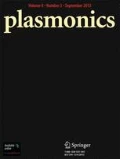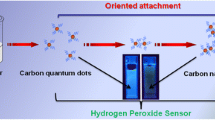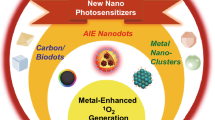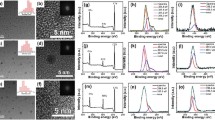Abstract
The deleterious effects of reactive oxygen species (ROS), including singlet oxygen (1O2), on biological systems have cultivated widespread interest in fields ranging from therapeutic techniques to sterilization materials. Researchers have, for example, sought to capitalize on the oxidative damage from singlet oxygen to treat tumors as well as to kill antibiotic resistant bacteria. To generate 1O2 in a controllable manner, photosensitizers are optimized to generate 1O2 from ground state oxygen (3O2) when excited by light. When considering applications of photosensitization, favorable properties include high 1O2 yield, low synthetic complexity, and minimal cost. Previously, studies have shown that plasmonic nanoparticles are able to amplify the photosensitization of 1O2 from small molecule photosensitizers in a mechanism similar to metal-enhanced fluorescence (MEF), thereby improving yield. A recent study from our lab has demonstrated that brominated carbon nanodots, which are an inexpensive and simple-to-collect as a hydrocarbon combustion byproduct, generate reactive oxygen species that can be used for antimicrobial photodynamic inactivation of bacteria. Herein we investigate the combination of these advantageous properties. Using the turn-on fluorescent probe Singlet Oxygen Sensor Green™ to detect 1O2, we report the metal-enhanced photosensitization of 1O2 by brominated dots in silvered Quanta Plate™ wells. These results provide a promising direction for the potential optimization of carbon nanodot-based agents in light-activated antimicrobial materials.



source used in photosensitization of the dots



Similar content being viewed by others
Abbreviations
- MEF :
-
– Metal-enhanced fluorescence
- MEP:
-
–Metal-enhanced phosphorescence
- ME1O2 :
-
–Metal-enhanced (photosensitization/generation of) singlet oxygen
- BrCND:
-
–Brominated carbon nanodots (brominated dots)
- SOSG™:
-
–Singlet Oxygen Sensor Green™
- ROS:
-
–Reactive oxygen species
- 1O2 :
-
–Singlet oxygen
- 3O2 :
-
–Ground state (triplet) oxygen
- APDI:
-
–Antimicrobial photodynamic inactivation of bacteria
References
Mróz P, Hamblin MR (2008) Advances in photodynamic therapy: basic, translational, and clinical. Artech House Series Engineering in Medicine & Biology. Boston: Artech House, Inc
Vázquez-Ortega F, Lagunes I, Trigos Á (2020) Cosmetic dyes as potential photosensitizers of singlet oxygen generation. Dyes Pigm 176. https://doi.org/10.1016/j.dyepig.2020.108248
Hu W, Lin Y, Zhang X-F, Feng M, Zhao S, Zhang J (2019) Heavy-atom-free charge transfer photosensitizers: tuning the efficiency of BODIPY in singlet oxygen generation via intramolecular electron donor-acceptor interaction. Dyes Pigm 164:139–147. https://doi.org/10.1016/j.dyepig.2019.01.019
Xian-Fu Z, Xudong Y, Baomin X (2017) PET-based bisBODIPY photosensitizers for highly efficient excited triplet state and singlet oxygen generation: tuning photosensitizing ability by dihedral angles. Phys Chem Chem Phys 19(36):24792–24804. https://doi.org/10.1039/c7cp02645e
Zhang Y, Aslan K, Previte MJR, Geddes CD (2008) Plasmonic engineering of singlet oxygen generation. PNAS 105(6):1798–1802. https://doi.org/10.1073/pnas.0709501105
Geddes CD, Karolin J (2013) Metal-enhanced fluorescence based excitation volumetric effect of plasmon-enhanced singlet oxygen and super oxide generation. Phys Chem Chem Phys 15(38):15740–15745
Zhang Y, Aslan K, Previte MJ, Geddes CD (2007) Metal-enhanced singlet oxygen generation: a consequence of plasmon enhanced triplet yields. J Fluoresc 4:345–349
Zhang Y, Aslan K, Previte MJR, Geddes CD (2007) Metal-enhanced superoxide generation: a consequence of plasmon-enhanced triplet yields. Applied Physics Letters 91. https://doi.org/10.1063/1.2753718
Aslan K, Geddes CD (2010) Metal-enhanced fluorescence: progress towards a unified plasmon-fluorophore description. In: Geddes CD (ed) Metal-Enhanced Fluorescence. John Wiley & Sons, Inc., Hoboken, New Jersey, pp 1–23
Karolin JO, Geddes CD (2012) Reduced lifetimes are directly correlated with excitation irradiance in metal-enhanced fluorescence (MEF). J Fluoresc 22(6):1659–1662
Dragan AI, Geddes CD (2012) Metal-enhanced fluorescence: the role of quantum yield, Q0, in enhanced fluorescence. Appl Phys Lett 100(9):093115. https://doi.org/10.1063/1.3692105
Jeong Y, Kook Y-M, Lee K, Koh W-G (2018) Metal enhanced fluorescence (MEF) for biosensors: general approaches and a review of recent developments. Biosens Bioelectron 111:102–116. https://doi.org/10.1016/j.bios.2018.04.007
Dragan AI, Geddes CD (2011) Excitation volumetric effects (EVE) in metal-enhanced fluorescence. Phys Chem Chem Phys 13(9):3831–3838
Zhang Y, Aslan K, Previte MJR, Malyn SN, Geddes CD (2006) Metal-enhanced phosphorescence: interpretation in terms of triplet-coupled radiating plasmons. J Phys Chem B 110(49):25108–25114. https://doi.org/10.1021/jp065261v
Zhang Y, Aslan K, Malyn SN, Geddes CD (2006) Metal-enhanced phosphorescence (MEP). Chem Phys Lett 427:432–437. https://doi.org/10.1016/j.cplett.2006.06.078
Knoblauch R, Ra E, Geddes CD (2019) Heavy carbon nanodots 2: plasmon amplification in Quanta PlateTM wells and the correlation with the synchronous scattering spectrum. Phys Chem Chem Phys 21(3):1254–1259. https://doi.org/10.1039/c8cp06299d
Mishra H, Mali BL, Karolin J, Dragan AI, Geddes CD (2013) Experimental and theoretical study of the distance dependence of metal-enhanced fluorescence, phosphorescence and delayed fluorescence in a single system. Phys Chem Chem Phys 15:19538–19544
Qi-Long Y, Gozin M, Feng-Qi Z, Cohen A, Si-Ping P (2016) Highly energetic compositions based on functionalized carbon nanomaterials. Nanoscale 8(9):4799–4851. https://doi.org/10.1039/c5nr07855e
Hong GS, Diao SO, Antaris AL, Dai HJ (2015) Carbon nanomaterials for biological imaging and nanomedicinal therapy. Chem Rev 115(19):10816–10906
Kumar P, Bohidar H (2012) Physical and fluorescent characteristics of non-functionalized carbon nanoparticles from candle soot. J Nanopart Res 14(7):1–10. https://doi.org/10.1007/s11051-012-0948-8
TripathiSonker KA, Sonkar S, Sarkar S (2014) Pollutant soot of diesel engine exhaust transformed to carbon dots for multicoloured imaging of E. coli and sensing cholesterol. RSC Adv 57:30100–30107
Sun Y-P, Zhou B, Lin Y, Wang W, Fernando KAS, Pathak P et al (2006) Quantum-sized carbon dots for bright and colorful photoluminescence. J Am Chem Soc 128(24):7756–7757
Tao S, Lu S, Geng Y, Zhu S, Redfern SAT, Song Y et al (2018) Design of metal-free polymer carbon dots: a new class of room-temperature phosphorescent materials. Angew Chem 130(9):2417–2422. https://doi.org/10.1002/ange.201712662
Knoblauch R, Bui B, Raza A, Geddes CD (2018) Heavy carbon nanodots: a new phosphorescent carbon nanostructure. Phys Chem Chem Phys 20(22):15518–15527. https://doi.org/10.1039/c8cp02675k
Li Q, Zhou M, Yang M, Yang Q, Zhang Z, Shi J (2018) Induction of long-lived room temperature phosphorescence of carbon dots by water in hydrogen-bonded matrices. Nat Commun 9(1):734–734. https://doi.org/10.1038/s41467-018-03144-9
Schmitz RD, Knoblauch R, Ra E, Geddes CD (2019) Alpha-fluorescence (αS1) from thermally stable carbon nanodots. Chem Phys Lett 721:123–128
Liu J, Wang N, Yu Y, Yan Y, Zhang H, Li J et al (2017) Carbon dots in zeolites: a new class of thermally activated delayed fluorescence materials with ultralong lifetimes. Sci Adv 3(5):e1603171. https://doi.org/10.1126/sciadv.1603171
Sarkar S, Gandla D, Venkatesh Y, Bangal P, Ghosh S, Yang Y et al (2016) Graphene quantum dots from graphite by liquid exfoliation showing excitation-independent emission, fluorescence upconversion and delayed fluorescence. Royal Society of Chemistry, Great Britain, p 21278
Jiang K, Wang Y, Li Z, Lin H (2020) Afterglow of carbon dots: mechanism, strategy and applications. Mat Chem Front 4:386–399
Knoblauch R, Harvey A, Ra E, Greenberg KM, Lau J, Hawkins E et al (2021) Antimicrobial carbon nanodots: photodynamic inactivation and dark toxicity effects on bacteria by brominated carbon nanodots. Nanoscale 13(1):85–99. https://doi.org/10.1039/D0NR06842J
Klonis N, Sawyer WH (1996) Spectral properties of the prototropic forms of fluorescein in aqueous solution. J Fluoresc 6(3):147–157
Knoblauch R, Geddes CD (2019) Reviews of advances in metal-enhanced fluorescence. In: Geddes CD (ed) Reviews in Plasmonics 2017. Springer Nature, Switzerland, pp 253–283
Strobbia P, Languirand E, Cullum BM (2015) Recent advances in plasmonic nanostructures for sensing: a review. Opt Eng 54(10):100902. https://doi.org/10.1117/1.OE.54.10.100902
Zhang Y, Aslan K, Previte MJR, Geddes CD (2008) Metal-enhanced excimer (P-type) fluorescence. Chem Phys Lett 458:147–151. https://doi.org/10.1016/j.cplett.2008.04.083
Sabatini CA, Pereira RV, Gehlen MH (2007) Fluorescence modulation of acridine and coumarin dyes by silver nanoparticles. J Fluoresc 17:377–382. https://doi.org/10.1007/s10895-007-0204-2
Saion E, Gharibshahi E, Naghavi K (2013) Size-Controlled and optical properties of monodispersed silver nanoparticles synthesized by the radiolytic reduction method. Int J Mol Sci 14(4):7880–7896. https://doi.org/10.3390/ijms14047880
Dragan AI, Mali B, Geddes CD (2013) Wavelength-dependent metal-enhanced fluorescence using synchronous spectral analysis. Chem Phys Lett 556:168–172. https://doi.org/10.1016/j.cplett.2012.11.035
Chen Y, Munechika K, Ginger DS (2007) Dependence of fluorescence intensity on the spectral overlap between fluorophores and plasmon resonant single silver nanoparticles. Nano Lett 7:690–696. https://doi.org/10.1021/nl062795z
Ragas X, Jimenez-Banzo A, Sanchez-Garcia D, Batllori X, Nonell S (2009) Singlet oxygen photosensitisation by the fluorescent probe Singlet Oxygen Sensor Green. Chem Commun 20:2920–2922
Kim S, Fujitsuka M, Majima T (2013) Photochemistry of Singlet Oxygen Sensor Green. J Phys Chem B 117(45):13985–13992
Gollmer A, Arnbjerg J, Blaikie FH, Pedersen BW, Breitenbach T, Daasbjerg K et al (2011) Singlet Oxygen Sensor Green®: photochemical behavior in solution and in a mammalian cell. Photochem Photobiol 87(3):671–679. https://doi.org/10.1111/j.1751-1097.2011.00900.x
Liu H, Carter PJH, Laan AC, Eelkema R, Denkova AG (2019) Singlet Oxygen Sensor Green is not a suitable probe for 1O2 in the presence of ionizing radiation. Sci Rep 9(1):8393. https://doi.org/10.1038/s41598-019-44880-2
Knoblauch R, Moskowitz J, Hawkins E, Geddes CD (2020) Fluorophore-induced plasmonic current: generation-based detection of singlet oxygen. ACS Sensors 5:1223–1229
Funding
This work was supported by the National Science Foundation Graduate Research Fellowship Program (2018262827) and the HHS/NIH/National Institute of General Medical Sciences (NIGMS) through the Chemistry/Biology Interface Program at the University of Maryland Baltimore County (5T32GM066706). The authors also received internal funding from the Institute of Fluorescence (IoF) as well as the Department of Chemistry and Biochemistry at the University of Maryland Baltimore County (UMBC).
Author information
Authors and Affiliations
Contributions
All experiments were designed, executed, plotted, and analyzed by Rachael Knoblauch under the mentorship of Prof. Chris D. Geddes. All experiments were conducted, and data exported and archived with the assistance of Amanda Harvey. The manuscript was written by Rachael Knoblauch, edited by Prof. Chris D. Geddes.
Corresponding author
Ethics declarations
Conflict of Interest
The authors declare no competing interests.
Additional information
Publisher's Note
Springer Nature remains neutral with regard to jurisdictional claims in published maps and institutional affiliations.
Rights and permissions
About this article
Cite this article
Knoblauch, R., Harvey, A. & Geddes, C.D. Metal-Enhanced Photosensitization of Singlet Oxygen (ME1O2) from Brominated Carbon Nanodots on Silver Nanoparticle Substrates. Plasmonics 16, 1765–1772 (2021). https://doi.org/10.1007/s11468-021-01438-1
Received:
Accepted:
Published:
Issue Date:
DOI: https://doi.org/10.1007/s11468-021-01438-1




